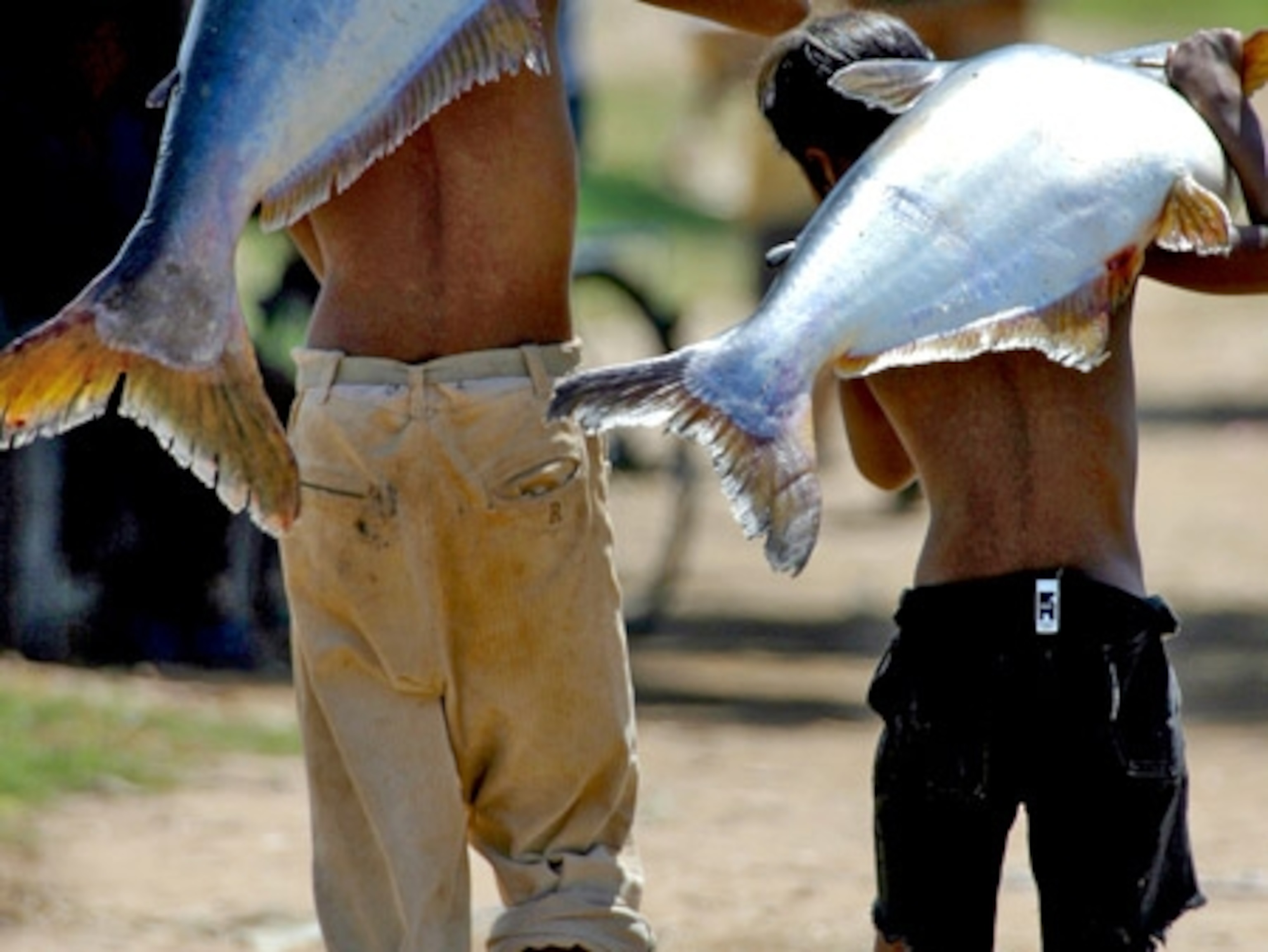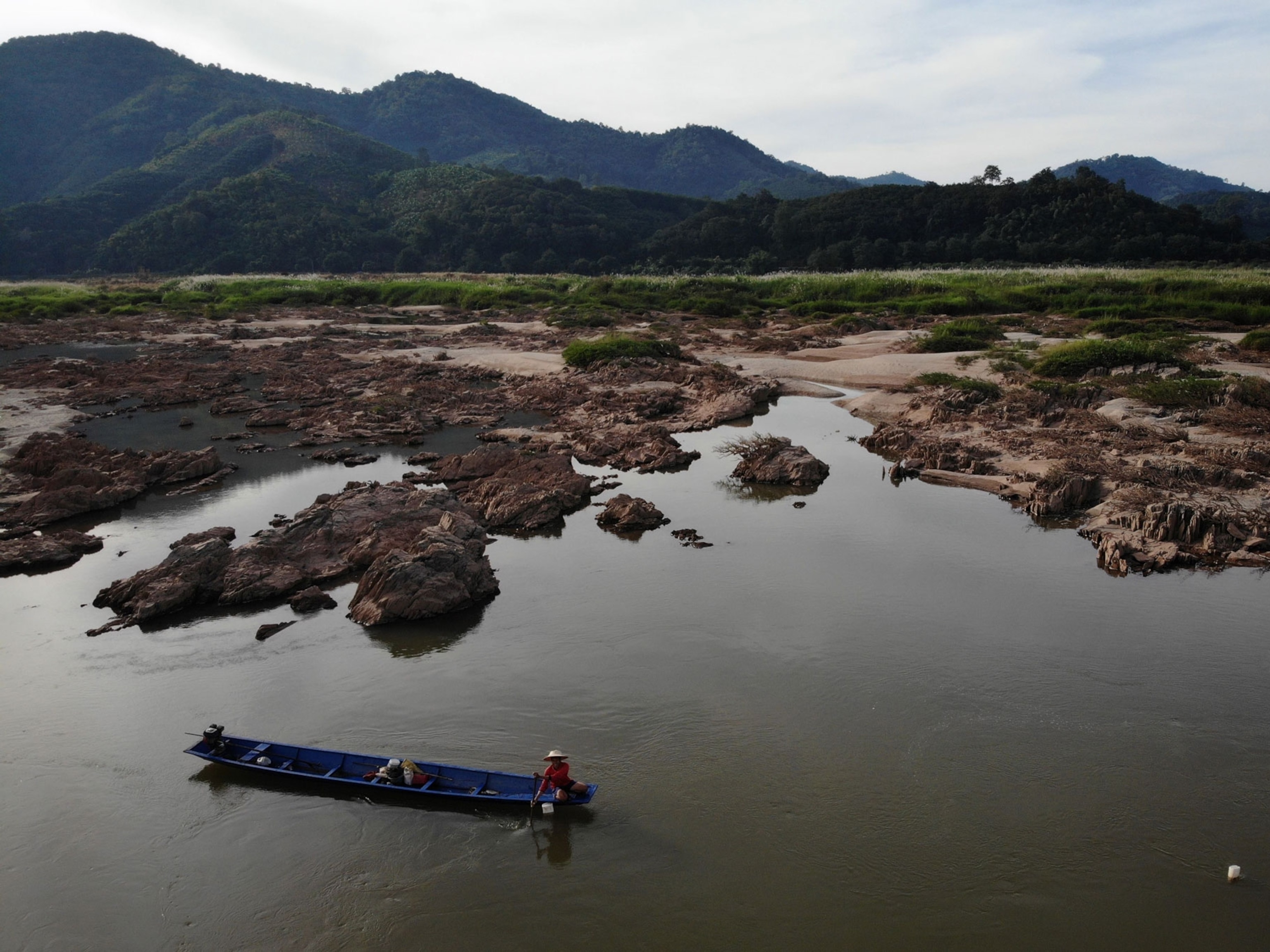Today's release of the World Conservation Union (IUCN) updated 2003 Red List of Threatened Species shows that the flagship species of the storied river in Southeast Asia is classified as Critically Endangered, its numbers further reduced from its classification as Endangered in the previous IUCN Red List. The Switzerland-based organization's members from 140 countries include some 70 states, 100 government agencies, and 750 NGOs.
"P. gigas—the largest freshwater fish according to the Guinness Book of Records—is now very rare in northeast Thailand, southern Lao PDR, and Vietnam," said IUCN in a news release issued today. "Only 11 and eight fish were caught in 2001 and 2002 respectively. In 2003, fishers captured six giant catfish in Cambodia, all of which were released as part of the Mekong Fish Conservation Project."
The disappearance of the Mekong giant catfish is a sign of the slow decline of environmental conditions throughout the river. Like many species in the Mekong, the giant catfish needs great stretches of the river to migrate seasonally—and it must have specific water quality and flow to move through its lifecycles of spawning, eating, and breeding.
But the Mekong is under threat from human development. Millions of people along its banks in Laos, Cambodia, and Vietnam rely on the river for their livelihood. Growing pressure by fisheries, damming, and habitat destruction threaten not only the giant catfish and other species that live in the river—but also the welfare of the people who depend on the Mekong.
National Geographic News spoke to Zeb Hogan of the Mekong Fish Conservation Project about the plight of the Mekong and its giant catfish. Hogan has received funding from the National Geographic Society to research and promote the conservation of the fish (see sidebar).
The Mekong giant catfish has just been listed by the IUCN as Critically Endangered. What does this mean and just how bad is it for this fish?
The Mekong giant catfish has been re-listed as Critically Endangered because we have new information which indicates that populations of the fish have declined significantly over the past several years. A hundred years ago, the Mekong giant catfish was found throughout the Mekong River Basin and reports indicate that fishermen harvested hundreds, or possibly even thousands, of fish per year. In recent times, the catch has dropped to between five and ten fish per year and the species has disappeared from almost all areas where it once occurred.
Why is the Mekong giant catfish so special, so important to keep it in the wild?
The Mekong giant catfish is one of the largest and most vulnerable freshwater species in the world. It is also a culturally important and charismatic species. The Mekong giant catfish symbolizes the ecological integrity of the Mekong River, because the species is so vulnerable to fishing pressure and changes in the river environment. Thus, the status of the species is one indicator of the health of the river. The recovery of the species is an important part of the sustainable management of the Mekong River Basin.
What are the main threats to the catfish?
Fishing is the most easily identifiable threat to the Mekong giant catfish. Dams, navigation projects, and habitat destruction also threaten the giant catfish. In the Mun River, the largest tributary to the Mekong, a dam blocks the migrations of giant catfish. The dam has isolated the Mun River fish populations from the remainder of the Mekong River Basin. For migratory species, such dams can disrupt several stages of the life cycle of the fish. In China, northern Lao PDR, and northern Thailand, the Mekong Navigation Improvement Project (blasting, dredging, and infrastructure development for navigation) threatens to destroy the only known spawning ground of the giant catfish.
How important is fishing—especially catfish—to the people who live on the Mekong? Can you tell us a bit about the economics of the industry?
The Mekong capture fishery is one of the largest in the world—with 1.5 million tons caught annually, 16 percent of the world total—according to recent studies by the Mekong River Commission. Catfish are one of the dominant food fish, popular in aquaculture, and frequently the basis of community-level fisheries. Annual production in Cambodia is 10,000 tons and in Vietnam exceeds 100,000 tons. Catfish represent 90 percent of all aquaculture, as much as 20 percent of inland capture fisheries in Cambodia, and account for the majority of the May to July harvest in southern Laos and northeastern Thailand.
There has been an unpleasant trade war between the U.S. and Vietnam about catfish farming. What is your analysis of the issue?
The U.S. Congress recently passed a law that makes it illegal to label Vietnamese catfish as "catfish" when marketed in the United States, even though these fish are commonly referred to as catfish according to a globally accepted science-based classification system. Vietnamese catfish must now be labeled as "basa fish" or "Pacific dory," names that have no meaning to United States consumers and make no sense from a scientific stand-point.
Personally I would like to see both sides spending more time and money investigating the environmental ramifications of aquaculture and trade policies, rather than wasting resources paying for nasty advertising and rubber-stamping protectionist legislation.
Is fish farming a threat to the overall health of the Mekong?
Managed correctly and sustainably, fish farming has the potential to increase fisheries productivity and provide food for hungry people. If fishers collect too many baby fish, wild populations decline. But, if fishers harvest sustainably, then the young fish can be raised to provide extra food. And, in fact, since aquaculture for this species is dependent on healthy fish populations and a healthy river ecosystem, the economic benefit gained from wild fish harvests provides an indirect incentive to protect the environment.
Who is involved in the conservation of the Mekong and its fish?
The Mekong Fish Conservation Project, in cooperation with the Cambodian Department of Fisheries, conducts research, conservation, and education on vulnerable populations of migratory fish of the Mekong, notably the Mekong giant catfish. Since 2000, the project has bought, tagged, and released over 20 Mekong giant catfish (about 80 percent of the total global catch) into the Tonle Sap River and Tonle Sap Lake.
The Thai Department of Fisheries has established an artificial breeding program for Mekong giant catfish (started in 1983). The Mekong Wetlands Biodiversity Program, together with the IUCN Water and Nature Initiative (based in Bangkok), recently conducted a biodiversity assessment and community fisheries study in Northern Lao PDR and Thailand. These studies produced evidence that the Mekong giant catfish spawns in the area that will likely be impacted by the Mekong Navigation Improvement Project.
The Mekong River Commission, the World Wide Fund for Nature (WWF), and the Wildlife Conservation Society (WCS) support conservation of Mekong River species. Local conservation initiatives, within the critical habitat of the giant catfish (such as the activities of the Wildlife Conservation Society, OSMOSE, and the Food and Agriculture Organization of the United Nations in the Tonle Sap Lake), result in some indirect protection of the species.
Tell us about your catfish book for the kids of Cambodia.
The Long Journey of the Giant Catfish is a very important part of our project, since it represents a longer term approach to biodiversity conservation—conservation education. The publisher of the book, the Cambodian organization Save Cambodia's Wildlife, plans to distribute the book to several thousand children throughout Cambodia.
Using a children's book about the giant catfish and the Mekong River, we are trying to introduce environmental knowledge in a way that's fun for kids. Kids love the colorful books, but it's too early to determine the long term impact of the project.
What hope is there that the decline will be reversed or at least halted?
When considering the Mekong River as a whole, there is still reason to be optimistic. The Mekong River has not been dammed below China, remains relatively unpolluted, and produces more aquatic resources for human consumption than any other river on the planet.
The Mekong giant catfish can be saved, but it will take a level of commitment from all countries of the lower Mekong, as well as international organizations and donor agencies, that currently does not exist. Finding resources for the conservation of the Mekong giant catfish is even more difficult in a region like the Mekong, where many people struggle for their livelihood and resources are scarce.
What in your opinion needs to be done at local, state, regional, and global levels to protect the Mekong and its systems of life?
At a local level, many communities are willing to protect the environments in which they live, so I think the main challenge is to educate and empower local people to do just that—sustainably manage the resources upon which they depend.
At a national level, governments need to provide incentives for biodiversity conservation. This includes, at a very basic level, provision of a stable political environment (not always easy in Southeast Asia), a fair legal system, and a certain amount of economic security, education, and health care. National governments also have a responsibility to cooperate with the governments of other nations and international organizations to protect and manage the Mekong River.
At a global level, we all need to recognize the importance of freshwater ecosystems. Though freshwaters constitute less than one tenth of one percent of the Earth's water supply, such ecosystems support tens of thousands of unique species and hundreds of millions of people. More than fifty percent of the Earth's freshwater is used by humans. With use, especially unmanaged use, comes environmental degradation and species extinctions. Global institutions, like the World Bank, and governments that impact global trends, like the United States, must place more importance in environmental protection and sustainable development.








